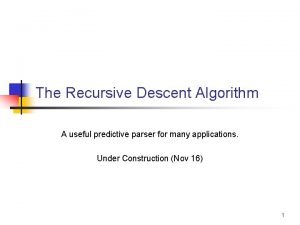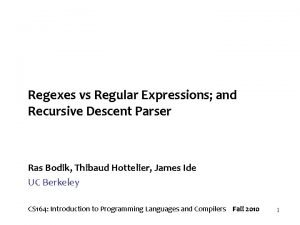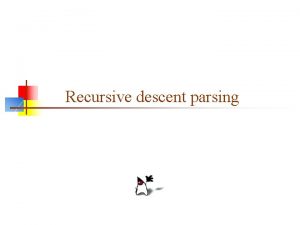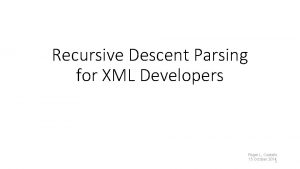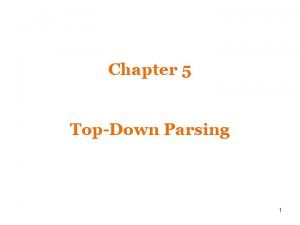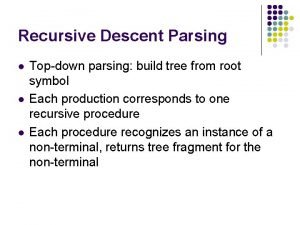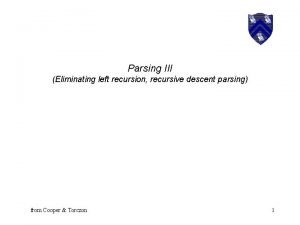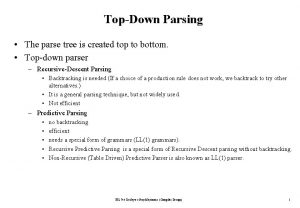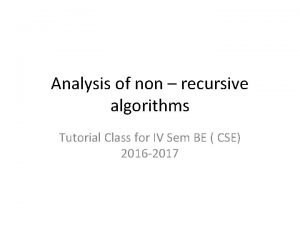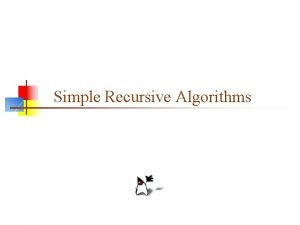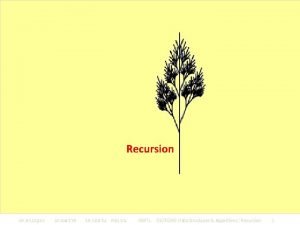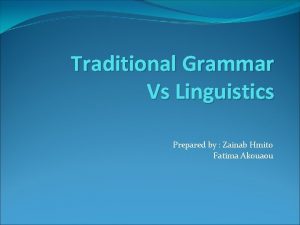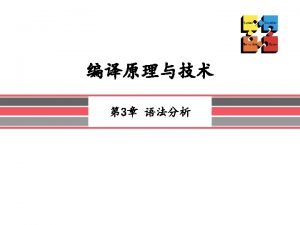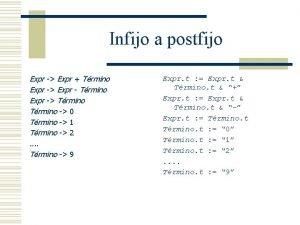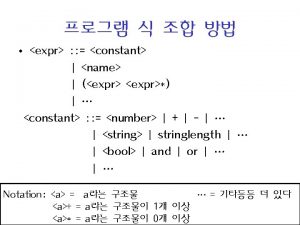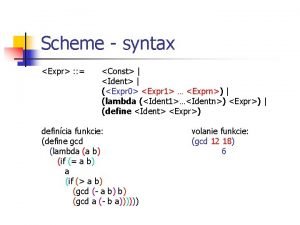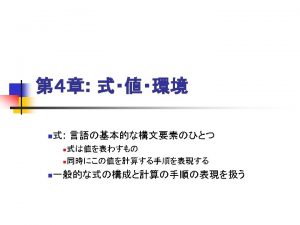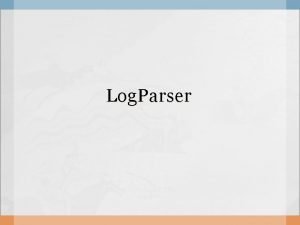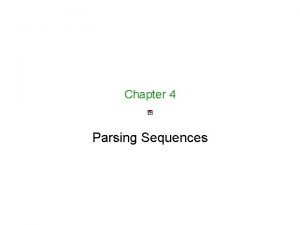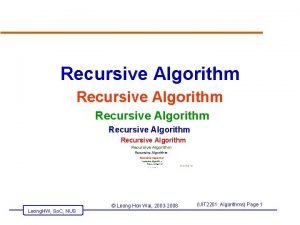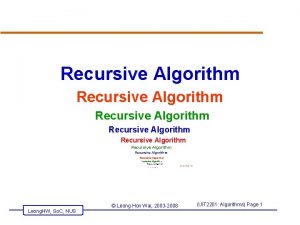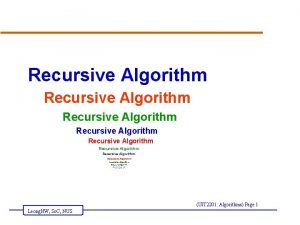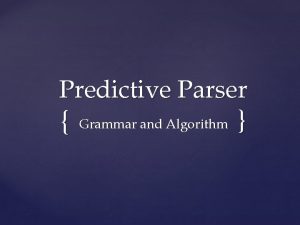Grammar vs Recursive Descent Parser expr term List






















- Slides: 22

Grammar vs Recursive Descent Parser expr : : = term. List : : = + term. List | - term. List | term : : = factor. List : : = * factor. List | / factor. List | factor : : = name | ( expr ) name : : = ident def expr = { term; term. List } def term. List = if (token==PLUS) { skip(PLUS); term. List } else if (token==MINUS) skip(MINUS); term. List } def term = { factor; factor. List }. . . def factor = if (token==IDENT) name else if (token==OPAR) { skip(OPAR); expr; skip(CPAR) } else error("expected ident or )")

Rough General Idea A : : = B 1. . . Bp | C 1. . . Cq | D 1. . . Dr where: def A = if (token T 1) { B 1. . . Bp else if (token T 2) { C 1. . . Cq } else if (token T 3) { D 1. . . Dr } else error("expected T 1, T 2, T 3") T 1 = first(B 1. . . Bp) T 2 = first(C 1. . . Cq) T 3 = first(D 1. . . Dr) first(B 1. . . Bp) = {a | B 1. . . Bp . . . aw } T 1, T 2, T 3 should be disjoint sets of tokens.

Computing first in the example expr : : = term. List : : = + term. List | - term. List | term : : = factor. List : : = * factor. List | / factor. List | factor : : = name | ( expr ) name : : = ident first(name) = {ident} first(( expr ) ) = { ( } first(factor) = first(name) U first( ( expr ) ) = {ident} U{ ( } = {ident, ( } first(* factor. List) = { * } first(/ factor. List) = { / } first(factor. List) = { *, / } first(term) = first(factor) = {ident, ( } first(term. List) = { + , - } first(expr) = first(term) = {ident, ( }

Algorithm for first Given an arbitrary context-free grammar with a set of rules of the form X : : = Y 1. . . Yn compute first for each right-hand side and for each symbol. How to handle • alternatives for one non-terminal • sequences of symbols • nullable non-terminals • recursion

Rules with Multiple Alternatives A : : = B 1. . . Bp | C 1. . . Cq | D 1. . . Dr first(A) = first(B 1. . . Bp) U first(C 1. . . Cq) U first(D 1. . . Dr) Sequences first(B 1. . . Bp) = first(B 1) if not nullable(B 1) first(B 1. . . Bp) = first(B 1) U. . . U first(Bk) if nullable(B 1), . . . , nullable(Bk-1) and not nullable(Bk) or k=p

Abstracting into Constraints recursive grammar: constraints over finite sets: expr' is first(expr) expr : : = term. List : : = + term. List | - term. List | term : : = factor. List : : = * factor. List | / factor. List | factor : : = name | ( expr ) name : : = ident nullable: term. List, factor. List expr' = term' term. List' = {+} U {-} term' = factor' factor. List' = {*} U{/} factor' = name' U { ( } name' = { ident } For this nice grammar, there is no recursion in constraints. Solve by substitution.

Example to Generate Constraints S : : = X | Y X : : = b | S Y Y : : = Z X b | Y b Z : : = | a S' = X' U Y' X' = terminals: a, b non-terminals: S, X, Y, Z reachable (from S): productive: nullable: First sets of terminals: S', X', Y', Z' {a, b}

Example to Generate Constraints S : : = X | Y X : : = b | S Y Y : : = Z X b | Y b Z : : = | a terminals: a, b non-terminals: S, X, Y, Z reachable (from S): S, X, Y, Z productive: X, Z, S, Y nullable: Z S' = X' U Y' X' = {b} U S' Y' = Z' U X' U Y' Z' = {a} These constraints are recursive. How to solve them? S', X', Y', Z' {a, b} How many candidate solutions • in this case? • for k tokens, n nonterminals?

Iterative Solution of first Constraints 1. 2. 3. 4. 5. S' X' Y' {} {} {b} {b} {a, b} {a, b} Z' {} {a} {a} S' = X' U Y' X' = {b} U S' Y' = Z' U X' U Y' Z' = {a} • Start from all sets empty. • Evaluate right-hand side and assign it to left-hand side. • Repeat until it stabilizes. Sets grow in each step • initially they are empty, so they can only grow • if sets grow, the RHS grows (U is monotonic), and so does LHS • they cannot grow forever: in the worst case contain all tokens

Constraints for Computing Nullable • Non-terminal is nullable if it can derive S : : = X | Y X : : = b | S Y Y : : = Z X b | Y b Z : : = | a S', X', Y', Z' {0, 1} 0 - not nullable 1 - nullable | - disjunction & - conjunction S' = X' | Y' X' = 0 | (S' & Y') Y' = (Z' & X' & 0) | (Y' & 0) Z' = 1 | 0 S' 1. 0 2. 0 3. 0 X' 0 0 0 Y' 0 0 0 Z' 0 1 1 again monotonically growing

Computing first and nullable • Given any grammar we can compute – for each non-terminal X whether nullable(X) – using this, the set first(X) for each non-terminal X • General approach: – generate constraints over finite domains, following the structure of each rule – solve the constraints iteratively • start from least elements • keep evaluating RHS and re-assigning the value to LHS • stop when there is no more change

Rough General Idea A : : = B 1. . . Bp | C 1. . . Cq | D 1. . . Dr where: def A = if (token T 1) { B 1. . . Bp else if (token T 2) { C 1. . . Cq } else if (token T 3) { D 1. . . Dr } else error("expected T 1, T 2, T 3") T 1 = first(B 1. . . Bp) T 2 = first(C 1. . . Cq) T 3 = first(D 1. . . Dr) T 1, T 2, T 3 should be disjoint sets of tokens.

Exercise 1 A : : = B EOF B : : = | B B | (B) • Tokens: EOF, (, ) • Generate constraints and compute nullable and first for this grammar. • Check whether first sets for different alternatives are disjoint.

Exercise 2 S : : = B EOF B : : = | B (B) • Tokens: EOF, (, ) • Generate constraints and compute nullable and first for this grammar. • Check whether first sets for different alternatives are disjoint.

Exercise 3 Compute nullable, first for this grammar: stmt. List : : = | stmt. List stmt : : = assign | block assign : : = ID ; block : : = beginof ID stmt. List ID ends Describe a parser for this grammar and explain how it behaves on this input: beginof my. Pretty. Code x = u; y = v; my. Pretty. Code ends

Problem Identified stmt. List : : = | stmt. List stmt : : = assign | block assign : : = ID ; block : : = beginof ID stmt. List ID ends Problem parsing stmt. List: – ID could start alternative stmt. List – ID could follow stmt, so we may wish to parse that is, do nothing and return • For nullable non-terminals, we must also compute what follows them

General Idea for nullable(A) A : : = B 1. . . Bp | C 1. . . Cq | D 1. . . Dr where: def A = if (token T 1) { B 1. . . Bp else if (token (T 2 U TF)) { C 1. . . Cq } else if (token T 3) { D 1. . . Dr } // no else error, just return T 1 = first(B 1. . . Bp) T 2 = first(C 1. . . Cq) T 3 = first(D 1. . . Dr) TF = follow(A) Only one of the alternatives can be nullable (e. g. second) T 1, T 2, T 3, TF should be pairwise disjoint sets of tokens.

LL(1) Grammar - good for building recursive descent parsers • Grammar is LL(1) if for each nonterminal X – first sets of different alternatives of X are disjoint – if nullable(X), first(X) must be disjoint from follow(X) • For each LL(1) grammar we can build recursive-descent parser • Each LL(1) grammar is unambiguous • If a grammar is not LL(1), we can sometimes transform it into equivalent LL(1) grammar

Computing if a token can follow first(B 1. . . Bp) = {a | B 1. . . Bp . . . aw } follow(X) = {a | S . . . Xa. . . } There exists a derivation from the start symbol that produces a sequence of terminals and nonterminals of the form. . . Xa. . . (the token a follows the non-terminal X)

Rule for Computing Follow Given X : : = YZ (for reachable X) then first(Z) follow(Y) and follow(X) follow(Z) now take care of nullable ones as well: For each rule X : : = Y 1. . . Yp. . . Yq. . . Yr follow(Yp) should contain: • first(Yp+1 Yp+2. . . Yr) • also follow(X) if nullable(Yp+1 Yp+2 Yr)

Compute nullable, first, follow stmt. List : : = | stmt. List stmt : : = assign | block assign : : = ID ; block : : = beginof ID stmt. List ID ends Is this grammar LL(1)?

Conclusion of the Solution The grammar is not LL(1) because we have • nullable(stmt. List) • first(stmt) follow(stmt. List) = {ID} • If a recursive-descent parser sees ID, it does not know if it should – finish parsing stmt. List or – parse another stmt
 Recursive descent parser calculator java
Recursive descent parser calculator java Recursive descent parser
Recursive descent parser Recursive descent parsing
Recursive descent parsing Limitations of recursive descent parser
Limitations of recursive descent parser Recursive top down parser
Recursive top down parser Nltk recursive descent parser
Nltk recursive descent parser Recursive descent parser
Recursive descent parser Left recursion and left factoring
Left recursion and left factoring Www.express.com
Www.express.com Top-down parser
Top-down parser Non recursive algorithm example
Non recursive algorithm example Recursive algorithms
Recursive algorithms Tower of hanoi python
Tower of hanoi python How to convert right linear grammar to left linear grammar
How to convert right linear grammar to left linear grammar Weaknesses of traditional grammar
Weaknesses of traditional grammar Type 0 grammar is called unrestricted grammar
Type 0 grammar is called unrestricted grammar Right linear grammar
Right linear grammar Long term plan and short term plan
Long term plan and short term plan Term-to-term rule
Term-to-term rule Long term memory vs short term memory
Long term memory vs short term memory Nth term of a sequence
Nth term of a sequence Long term hr planning
Long term hr planning Term to term rule
Term to term rule
